Here are five possible acquisition targets to keep an eye on.
Biotech stocks have been on a rise for about the last year. The SPDR Biotech ETF grew more than 50 percent in the last year and iShares Biotechnology ETF grew about 30 percent compared to the S&P SPX, which grew about 25 percent in the same period. Mergers and acquisitions are expected to be big this year because of the tax changes providing corporations with more cash, and it’s off to a good start with Celgene buying Juno Therapeutics and Sanofi buying Bioverativ. Here are five possible acquisition targets to keep an eye on.
Headquartered in Novato, California, BioMarin focuses on rare genetic diseases. It has six commercial products for CLN2 Disease, Morquio A Syndrome MPS IVA, PKU, MPS VI, MPS I and for LEMS. The company is waiting on a decision by the U.S. Food and Drug Administration (FDA) in late May for its Biologics License Application (BLA) for its PEGylated recombinant phenylalanine ammonia lyase enzyme product to reduce blood phenylalanine (Phe) levels in patients with phenylketonuria (PKU) who have uncontrolled blood Phe levels.
MarketWatch notes, “Admittedly, one of the biggest hurdles for a buyout of BioMarin in the past has been its relatively large size compared with other development-stage biotechs. It’s valued at more than 10 times revenue and sports a total price tag of about $16 billion. However, that valuation is because of substantive research and viable treatments already in market.”
Bluebird bio is based in Cambridge, Mass., and is a clinical-stage biotech focused on gene therapies and T-cell-based immune-oncology therapies. At the American Society of Hematology Annual Meeting in December 2017, bluebird presented data on its LentiGlobin gene therapy in severe sickle cell disease and transfusion-dependent beta-thalassemia. And in June presented positive early-stage data from its CAR-T therapy BB2121 for multiple myeloma, which it collaborates on with Celgene.
Over the last 12 months, bluebird bio stock has almost tripled. It has a market cap of about $8 billion.
MarketWatch writes, “The biggest reason is a cancer therapy for multiple myeloma that saw pretty big success in December, with more than half of patients seeing a complete recovery from the disease. This kind of success is simply too impressive to overlook. In the words of one doctor quoted by a recent Bloomberg news report, ‘Most of these patients were ready for hospice, and this came along.’”
Located in San Diego, California, Acadia focuses on central nervous system (CNS) disorders. In November 2017, the company presented data from its Phase II trial of pimavanserin in Alzheimer’s disease psychosis. It met the primary endpoint in the study, showing a statistically significant decrease in psychosis compared to placebo. The drug was approved at the end of 2016 for hallucinations and delusions associated with Parkinson’s, but Alzheimer’s is a much larger market.
“Any effective treatment that gets approval would catapult to instant blockbuster status,” MarketWatch reports. “However, investors have soured on Acadia’s stock lately as the drumbeat of acquisition rumors have slowed recently; shares are down about 25 percent from their October highs. However, in fiscal 2017 the company saw substantial revenue growth from a mere $17 million to more than $125 million. Furthermore, that revenue should double in fiscal 2018 if projections hold.”
Headquartered in Wilmington, Delaware, Incyte has been at the top of acquisition target lists since 2016 or longer. In 2016, Evercore ISI published a survey of 244 biotech industry observes, and Incyte was at the top of that list. Potential buyers have been speculated to be Gilead, Eli Lilly and Novartis, among others. But so far nobody’s bitten.
The chief incentive has been its two commercial products, Jakafi and Iclusig. Jakafi is a JAK1 and JAK2 inhibitor to treat polycythemia vera. Peak sales are projected at $3 billion. Iclusig is for chronic myeloid leukemia and acute lymphoblastic leukemia.
MarketWatch writes, “This $20 billion biotech was a $30 billion biotech as recently as last spring. However, the rejection of a co-developed arthritis medication hit the stock and its partner, Eli Lilly, pretty hard last year…. However, all is not lost for Incyte shareholders—and in fact, new money may want to consider buying in at these stubbornly depressed valuations now that the dust has settled over the last several months.”
Based in Stamford, Connecticut, Cara focuses on developing therapeutics for pain, inflammation and pruritus. Shares were all over the place in 2017, with a high of $28 and a low of $11. It started this year around $14, but 2018 also has a number of potential catalysts for several of its non-opioid pain medications.
“Of course,” MarketWatch notes, “as with all small biotech stocks, a successful investment in Cara is wholly dependent on the results of its 2018 trials. After all, doctors are not going to stop prescribing currently proven medications for their patients if the alternative is not at least marginally better—or, a nightmare scenario for Cara, if the treatments don’t even perform as well.”





